ATI's Radeon X800 XL 512MB - A toe in the 512MB pool
by Anand Lal Shimpi on May 4, 2005 9:27 AM EST- Posted in
- GPUs
At the end of last year, ATI announced 5 new GPUs, three of which were supposed to be available within a week of the announcement, none of which actually were. One of those GPUs, the X800 XL, was of particular interest as it was ATI's first real answer to NVIDIA's GeForce 6800GT and ATI said that it would be priced a full $100 less than NVIDIA's offering. Of course, that GPU didn't arrive on time either. And when it did, you had to pay a lot more than $299 to get it.
Fast forward to the present day and pretty much everything is fine. You can buy any of the GPUs that ATI announced at the end of last year at or below their suggested retail prices. But, we have another GPU release on our hands, and given ATI's recent track record, we have no idea if we're talking about a GPU that will be out later this month as promised or one that won't see the light of day for much longer.
Today, ATI is announcing their first 512MB graphics card - the Radeon X800 XL 512MB. Priced at $449, ATI's Radeon X800 XL 512MB is identical in every aspect to the X800 XL, with the obvious exception of its on-board memory size. The X800 XL 512MB is outfitted with twice as many memory devices as the 256MB version, but ATI is indicating that there's no drop in performance despite the increase in memory devices. The clock speeds of the X800 XL 512MB remain identical to the 256MB version, at 400MHz core and 980MHz memory. The 512MB version is also built on the same 0.11-micron R430 GPU as the 256MB version; in other words, the GPUs are identical - one is just connected to twice as much memory. Right now, the X800 XL 512MB is PCI Express only.
The board layout and design hasn't changed with the move to 512MB. The power delivery circuitry is all the same. The difference is that now there are twice as many memory devices on the PCB.
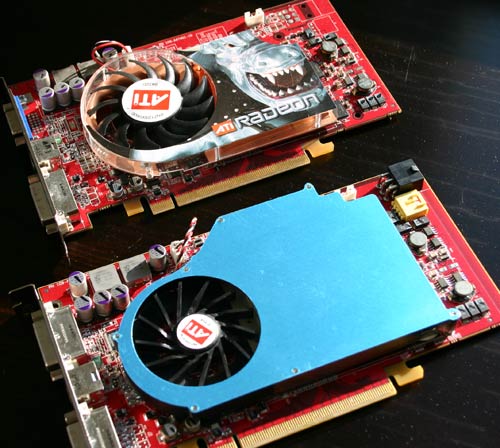
The two X800 XLs: 512MB (lower), 256MB (upper).

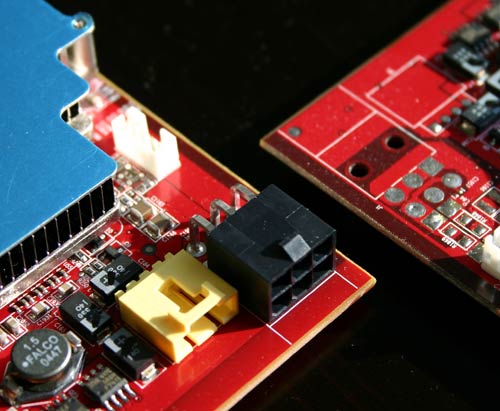
The X800 XL 512MB also now requires the 6-pin PCI Express power connector, something that the original 256MB board didn't need.
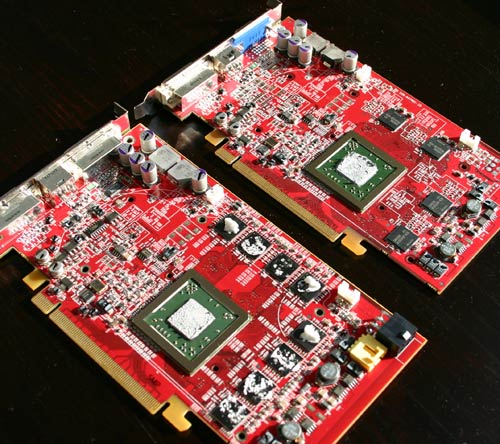
The X800 XL 512MB achieves its memory capacity by using twice the number of chips as the 256MB version.
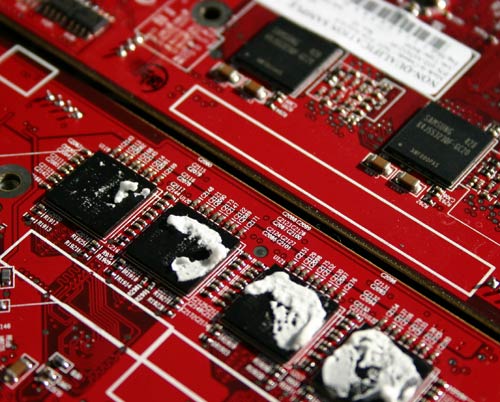
This is where ATI's strategy doesn't seem to make much sense. They are taking a mid-range performance part, the X800 XL, and giving it more memory than any of their GPUs, thus pricing it on par with their highest end X850 XT. More than anything, ATI is confusing their own users with this product. Those who are uninformed and have a nice stack of cash to blow on a new GPU are now faced with a dilemma: $449 for a 512MB X800 XL or $499 for a 256MB X850 XT? That is, if this part does actually ship to market in time and if it is actually priced at $449 - both assumptions that we honestly can't make anymore given what we've seen with the past several ATI releases.
What's also particularly interesting about today's 512MB launch is that ATI won't be producing any 512MB X800 XL cards under the "built by ATI" name. You will only be able to get these cards through ATI's partners. According to ATI, the following manufacturers will bring the X800 XL 512MB to market sometime this month:
- GigabyteAnd as confirmation, here's a slide from ATI's presentation saying the exact same thing:
- TUL
- Sapphire
- HIS
- MSI
- ABIT
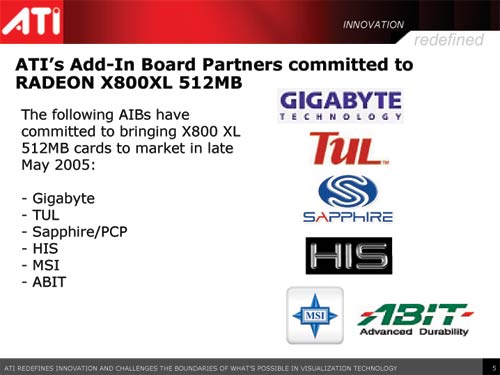
It is worth noting that NVIDIA has been shipping a 512MB card, the 512MB GeForce 6800 Ultra, for quite some time now. However, the card itself only seems to be available to system builders such as Alienware and Falcon Northwest. The 512MB 6800 Ultra is extremely expensive and appears to add around $800 to the cost of any system built by those who carry it; obviously, not in the same price range as ATI's X800 XL 512MB. Despite our curiosities, we could not get a card from NVIDIA in time for this review, although we'd be willing to bet that our findings here with the X800 XL 512MB would apply equally to NVIDIA's 512MB GeForce 6800 Ultra as well.










70 Comments
View All Comments
Fricardo - Wednesday, May 4, 2005 - link
*terrible idea*Fricardo - Wednesday, May 4, 2005 - link
I knew that card was a terrible as soon as I read the title. How could ATI be so retarded? Doesn't even make sense...Patman2099 - Wednesday, May 4, 2005 - link
I could be mistaken, but isnt the Default FSAA on cards now using Multi sampling or mix of multi and super sampling?Perhaps ATI intends to bring back pure Super Sampling?
mbhame - Wednesday, May 4, 2005 - link
Anand,There are more sites supporting your findings than contradicting your findings (ExtremeTech) - which wouldn't be a first for ExtremeTech.
Your final comment in Post #21 couldn't have made me any happier - I'm tired of arguing with people who think slapping tons of RAM on anything dictates tons more performance, etc.
Could you let us know how much is local and how much is shared system RAM in the recently-announced 512MB 6200's?
Hey, when are you going to reply to my email? :P
Cygni - Wednesday, May 4, 2005 - link
The card companies pushed 64meg cards when 32meg cards werent even close to maxed out. Then 128 when 64 was perfectly find. Then 256. Then 512. Its what they do, and the consumers have SHOWED the board makers again and again that they will pay out the nose for that extra RAM just to be "future proof", regardless of actual performance. They arent evil, but they have learned what sells. A 64meg card is JUST NOW becoming "needed" in most games.The two monitors i have in my house, Sony 200sx's (about 5 of em, all from around 1996 :D ) and early release 17in flatpanels (Dell and Mitsu) both are most useable at 1024x768, so i never even touch reso's higher than that in any games. Its not worth it to me. Personally, the gaganess for high reso, high AA, high AF gaming confuses me... especially at the increadible cost in both FPS and dollars to run that high. The visual difference is less noticeable than simple environ bump maps to me.
fishbits - Wednesday, May 4, 2005 - link
Won't someone think of the poor starving gamers that don't have 256MB DDR3, much less an extra thus far-useless, overpriced 256MB of DDR3?Perhaps it could come in handy though in MOGs, where you're going back and forth through different zones and coming across the same characters multiple times, and it isn't as clearly defined as loading the next FPS level/map. "Hey, Jerx0r the Brave is still in video memory, don't have to reload him!" Of course it may not be a big hit if its already in system RAM, but with high-end systems running 1GB + 256MB, it's a decent bump up in total RAM.
AlexWade - Wednesday, May 4, 2005 - link
Someone will buy it. Someone with deep pockets. If you are thinking about buying this card, can you give me some of your extra money?Anand Lal Shimpi - Wednesday, May 4, 2005 - link
ETI meant that it's not related to video memory size. If it were system memory related then it would affect both cards equally, but the test is cached and I noticed no disk related slowdowns during the benchmarking. If you really want I'll run it with 2GB of memory though, just ask and I shall do :)
Take care,
Anand
ET - Wednesday, May 4, 2005 - link
Thanks for the comment, Anand. Why do you say "it's not related to memory size". Do you get the same scores with 2GB of RAM?Anand Lal Shimpi - Wednesday, May 4, 2005 - link
For those wondering, I also ran tests under Doom 3 at 1600x1200 with 4X AA (8X AF) on the High Quality setting. The performance between the two cards is as follows:512MB - 31.0 fps
256MB - 31.0 fps
This agrees with the High vs. Ultra performance numbers we saw in our first Doom 3 GPU review [http://www.anandtech.com/video/showdoc.aspx?i=2146...].
There's no magic increase in performance if you back down to the High quality setting, so if you're seeing numbers contrary to what I've shown here something fishy is going on and it's not related to memory size.
For those of you wondering why Doom 3's Ultra Quality mode doesn't require a 512MB video card, keep in mind that the test we're running here is reporting average frame rates. Doom 3's timedemo function doesn't output minimum frame rates, but through actual game play the 512MB card is a bit smoother with the Ultra quality settings enabled (only in Doom 3 however). The difference isn't huge in the scenarios we tested.
I have no doubt that 512MB boards will make sense sometime down the road, but not paired up with this GPU.
Take care,
Anand